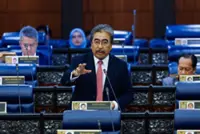Maurice Bompard's 'Harvesting Dates In Chetma' (oil on canvas, 1891) seen at the Islam Arts Museum Malaysia's exhibition 'The Orientalist Paintings: Mirror Or Mirage?'. Photo: The Star/Azlina Abdullah
When travellers to the Eastern world returned home to share captivating tales of their adventures, they ignited the imagination of their audience. Among these intrepid explorers were artists who, inspired by their experiences, sought to capture the essence of the Orient through paintings, sculptures and various artistic forms.
Unsurprisingly, the emergence of Orientalist art in the 19th century coincided with a period of heightened exploration and colonial expansion by Western powers, reflecting a growing fascination with the East.
Already a subscriber? Log in
Save 30% OFF The Star Digital Access
Cancel anytime. Ad-free. Unlimited access with perks.





